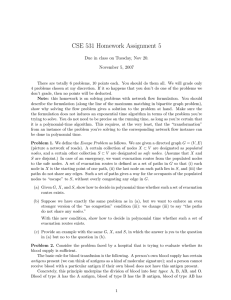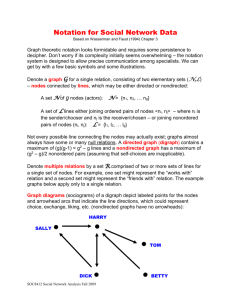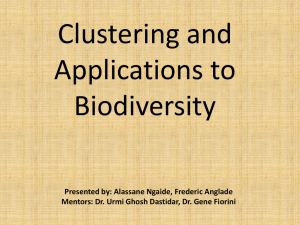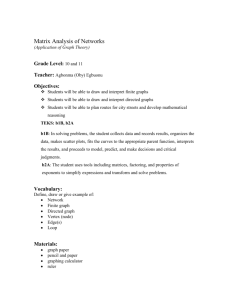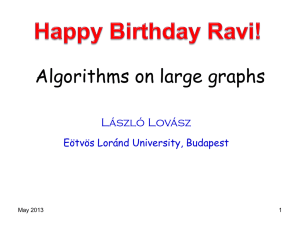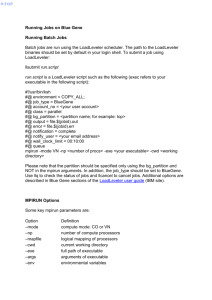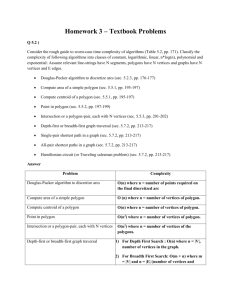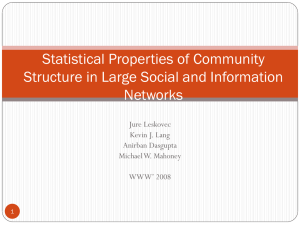Graph Partitioning & Kernighan-Lin Algorithm
advertisement
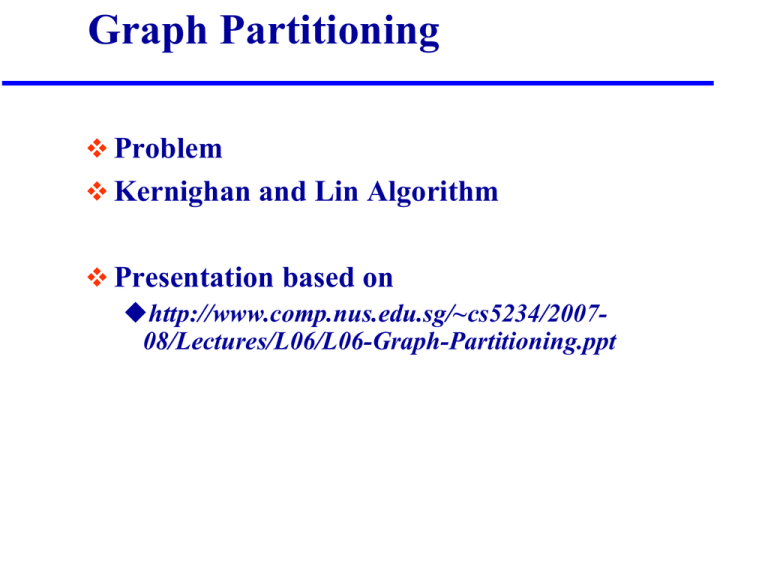
Graph Partitioning
Problem
Kernighan and Lin Algorithm
Presentation based on
http://www.comp.nus.edu.sg/~cs5234/200708/Lectures/L06/L06-Graph-Partitioning.ppt
Sparse Matrix partitioning
Graph Segmentation
To partition N into 2k parts
bisect (i.e. cut into two pieces) graph recursively k
times
Problem Formulation
Input: A weighted graph G = (V, E) with
Vertex set V. (|V| = 2n)
Edge Set E. (|E| = e)
Cost cAB for each edge (A, B) in E.
Output: 2 subsets X & Y such that
V = X Y and X Y = { } (i.e. partition)
Each subset (group) has n vertices
Total cost of edges “crossing” the partition is
minimized.
This problem is NP-Complete!!!!!
Brute Force Method
Try all possible bisections. Choose the best one.
If there are 2n vertices,
# of possibilities = (2n)! / (n!)2 = nO(n)
For 4 vertices (A,B,C,D), 3 possibilities
1. X = {A, B} & Y = {C, D}
2. X = {A, C} & Y = {B, D}
3. X = {A, D} & Y = {B, C}
For 100 vertices,
5 x 1028 possibilities!
Brute force not possible!
Kernighan and Lin heuristic
“An Efficient Heuristic Procedure for Partitioning
Graphs” B. W. Kernighan and S. Lin, The Bell
System Technical Journal, 49(2):291-307, 1970
Idea of KL Algorithm
Start with any initial partition X and Y.
A pass or iteration means exchanging each vertex A X
with each vertex B Y exactly once:
1. For i := 1 to n do
From the unlocked (unexchanged) vertices,
choose a pair (A,B) s.t. gain(A,B) is largest.
Exchange A and B. Lock A and B.
Let gi = gain(A,B).
2. Find the k s.t. G=g1+...+gk is maximized.
3. Switch the first k pairs.
Repeat the pass until there is no improvement (G=0).
Kernighan-Lin Algorithm (1)
a
4
2
3
1
d
4
3
e
2
2
c
6
Given:
b
Initial weighted graph G with
V(G) = { a, b, c, d, e, f }
1
f
Start with any partition of
V(G) into X and Y, say
X = { a, c, e }
Y = { b, d, f }
KL algorithm (2a)
a
4
2
3
1
2
2
c
d
4
3
e
b
6
1
f
Compute the gain values of moving
node x to the others set:
Gx = Ex - Ix
Ex = cost of edges connecting node x
with the other group (extra)
Ix = cost of edges connecting node x
within its own group (intra)
cut-size = 3+1+2+4+6 = 16
X = { a, c, e }
Y = { b, d, f }
Ga = Ea – Ia = – 3
Gc = Ec – Ic = 0
Ge = Ee – Ie = + 1
Gb = Eb – Ib = + 2
Gd = Ed – Id = – 1
Gf = Ef – If = + 9
(= 3 – 4 – 2)
(= 1 + 2 + 4 – 4 – 3)
(= 6 – 2 – 3)
(= 3 + 1 –2)
(= 2 – 2 – 1)
(= 4 + 6 – 1)
KL algorithm (2b)
a
4
2
3
1
2
2
c
d
4
3
e
b
6
1
f
Cost saving when exchanging a and b is
essentially Ga + Gb
However, the cost saving 3 of the direct
edge was counted twice. But this edge
still connects the two groups
Hence, the real “gain” (i.e. cost saving)
of this exchange is gab = Ga + Gb - 2cab
X = { a, c, e }
Y = { b, d, f }
Ga = Ea – Ia = – 3 (= 3 – 4 – 2)
Gb = Eb – Ib = + 2 (= 3 + 1 – 2)
gab = Ga + Gb – 2cab = – 7 (= – 3 + 2 – 2.3)
KL algorithm (3)
a
b
1
4
2
3
d
4
3
e
6
Gb = +2
Gd = –1
Gf = +9
2
2
c
Ga = –3
Gc = 0
Ge = +1
1
f
cut-size = 16
Pair with
maximum gain
Compute all the gains
gab = Ga + Gb – 2wab = –3 + 2 – 23 = –7
gad = Ga + Gd – 2wad = –3 – 1 – 20 = –4
gaf = Ga + Gf – 2waf = –3 + 9 – 20 = +6
gcb = Gc + Gb – 2wcb = 0 + 2 – 21 = 0
gcd = Gc + Gd – 2wcd = 0 – 1 – 22 = –5
gcf = Gc + Gf – 2wcf = 0 + 9 – 24 = +1
geb = Ge + Gb – 2web = +1 + 2 – 20 = +3
ged = Ge + Gd – 2wed = +1 – 1 – 20 = 0
gef = Ge + Gf – 2wef = +1 + 9 – 26 = –2
KL algorithm (4)
a
b
1
4
2
3
2
2
c
e
6
4
d
4
3
f
1
f
cut-size = 16
Exchange nodes
a and f
2
1
2
c
6
3
e
b
1
d
4
2
a
cut-size = 16 – 6 = 10
Then lock up
nodes a and f
gaf = Ga + Gf – 2caf = –3 + 9 – 20 = +6
3
KL algorithm (5)
f
4
2
1
2
c
6
b
1
3
d
3
Ga = –3
Gc = 0
Ge = +1
Gb = +2
Gd = –1
Gf = +9
X’ = { c, e }
Y’ = { b, d }
4
e
2
a
cut-size = 10
Update the G-values of unlocked nodes
G’c = Gc + 2cca – 2ccf = 0 + 2(4 – 4) = 0
G’e = Ge + 2cea – 2cef = 1 + 2(2 – 6) = –7
G’b = Gb + 2cbf – 2cba= 2 + 2(0 – 3) = –4
G’d = Gd + 2cdf – 2cda = –1 + 2(1 – 0) = 1
KL algorithm (6)
f
4
6
2
1
2
3
G’b = –4
G’d = +1
b
1
c
G’c = 0
G’e = –7
d
3
X’ = { c, e }
Y’ = { b, d }
4
e
2
a
cut-size = 10
Compute the gains
g’cb = G’c + G’b – 2ccb = 0 – 4 – 21 = –6
g’cd = G’c + G’d – 2ccd = 0 + 1 – 22 = –3
g’eb = G’e + G’b – 2ceb = –7 – 4 – 20 = –11
g’ed = G’e + G’d – 2ced = –7 + 1 – 20 = –6
Pair with maximum gain
(can also be neative)
KL algorithm (7)
f
4
2
1
2
c
6
f
b
1
3
e
1
2
2
d
d
6
4
2
1
3
a
cut-size = 10
Exchange nodes c
and d
b
4
c
3
e
2
3
4
a
cut-size = 10 – (–3) = 13
Then lock up
nodes c and d
g’cd = G’c + G’d – 2ccd = 0 + 1 – 22 = –3
KL algorithm (8)
f
1
4
1
2
2
d
6
c
3
e
2
G’c = 0
G’e = –7
b
4
a
cut-size = 13
G’b = –4
G’d = +1
3
X” = { e }
Y” = { b }
Update the G-values of unlocked nodes
G”e = G’e + 2ced – 2cec = –7 + 2(0 – 3) = –1
G”b = G’b + 2cbd – 2cbc= –4 + 2(2 – 1) = –2
Compute the gains
Pair with max. gain
is (e, b)
g”eb = G”e + G”b – 2ceb = –1 – 2 – 20 = –3
KL algorithm (9)
Summary of the Gains…
g = +6
g + g’ = +6 – 3 = +3
g + g’ + g” = +6 – 3 – 3 = 0
Maximum Gain = g = +6
Exchange only nodes a and f.
End of 1 pass.
Repeat the Kernighan-Lin.
Time Complexity of KL
For each pass,
O(n2) time to find the best pair to exchange.
n pairs exchanged.
Total time is O(n3) per pass.
Better implementation can get O(n2lg n) time
per pass.
Number of passes is usually small.

